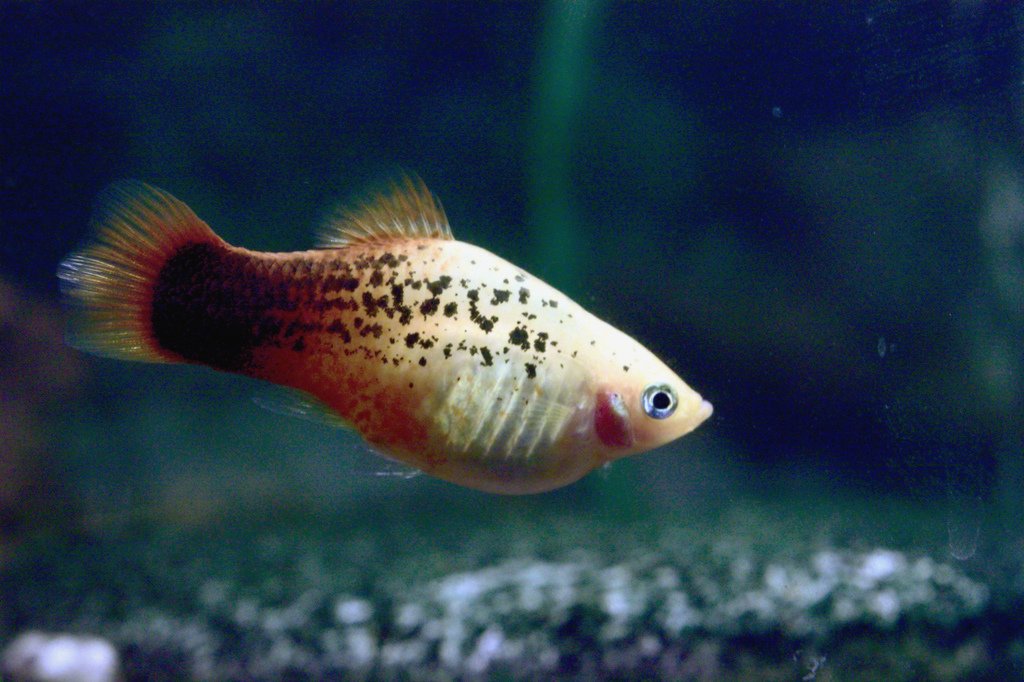Hey there! Let’s talk about the lively and lovely platy fish, scientifically known as members of the Xiphophorus genus. These little fellas belong to the Poeciliidae family, which they share with popular aquarium staples like guppies, mollies, and swordtails. There’s a wide array of species under the platy umbrella, each more radiant and captivating than the last. From the bright Sunset Platy to the intriguing Mickey Mouse Platy, the colors, and patterns they sport are simply fantastic!
Now, platy fish aren’t some exotic rarity you’d only hear about in hushed whispers among aquarist circles. No, these charismatic swimmers are quite popular and loved by many fish hobbyists. Their vibrant colors, friendly temperament, and ease of care make them a top choice, especially for beginners testing the waters of fishkeeping.
The natural habitats of these charming critters span the east coast of Central America and the southern edge of North America. Imagine them frolicking around in warm springs, peaceful canals, and slow-moving rivers. They’re pretty adaptable, too, as they’re comfortable swimming in the middle, top, or bottom of the water column. Talk about versatility!
Did you know they’re livebearers? That’s right, instead of laying eggs like most fish, platies give birth to live young! Plus, they’re omnivores with a taste for small invertebrates, algae, and plant matter. A varied diet makes for a happy platy.
And for a dash of excitement, here’s a fun fact: the Mickey Mouse Platy gets its whimsical name from the silhouette-like marking at its tail base. It resembles, yep, you guessed it, Disney’s beloved character. Who knew fish could carry such cute pop culture references, right?
Taking a brief dip into history, platy fish were first discovered in the late 19th century. Their eye-catching colors and hardy nature quickly made them a hit among aquarists. They’ve been selectively bred for generations to bring out an even wider array of beautiful colors and patterns. Today, platies are beloved members of the freshwater aquarium world, bringing joy and color to fish enthusiasts around the globe.
In the next sections, we’ll delve deeper into how to take care of your platy fish, as well as answer some common FAQs. So stick around, and let’s continue this journey with our captivating platy pals!
Table of Contents
How Much Do Platy Fish Cost? Common Names and Vibrant Variants
When it comes to pricing, Platy fish are quite affordable. The cost can vary depending on the size, color, variant, and where you buy them, but on average, you can expect to pay anywhere from $2 to $5 per fish.
Platy fish are known by several common names, many of which correspond to their color variants. Some of these names include Southern Platy (Xiphophorus maculatus), Variable Platy (Xiphophorus variatus), Moonfish, and the most charming of them all, the “Mickey Mouse” Platy.
The Platy fish come in an impressive array of variants, each with its unique charm:
Sunset Platy
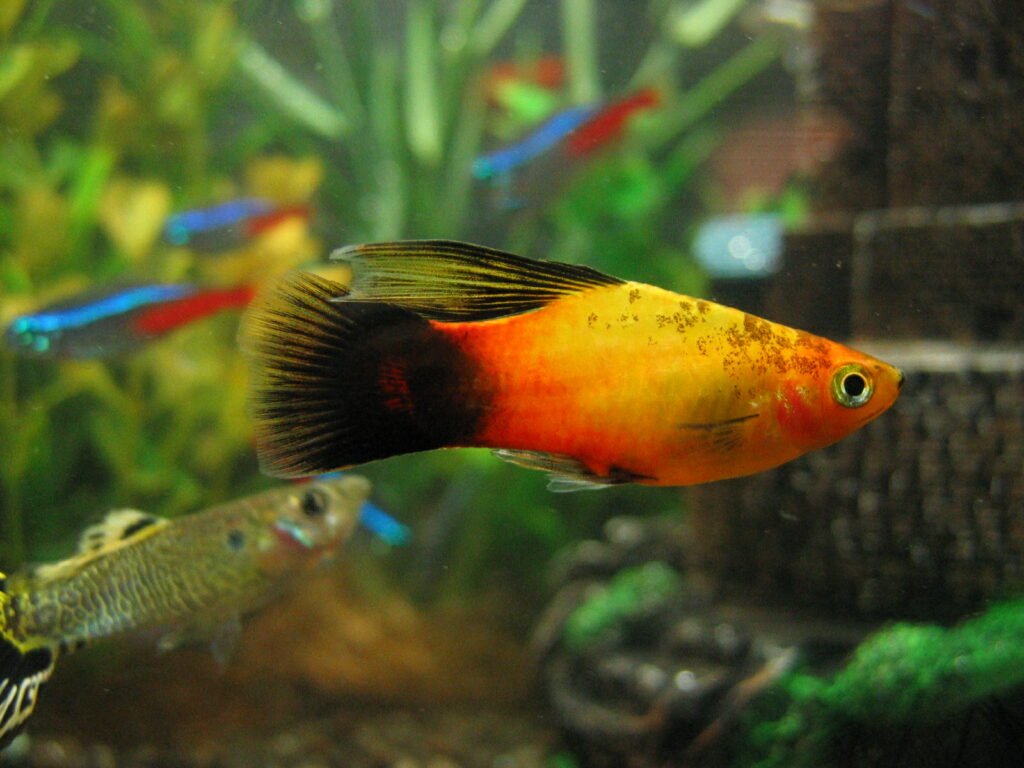
Renowned for their striking orange and black coloration, making them stand out in any aquarium.
Tuxedo Platy
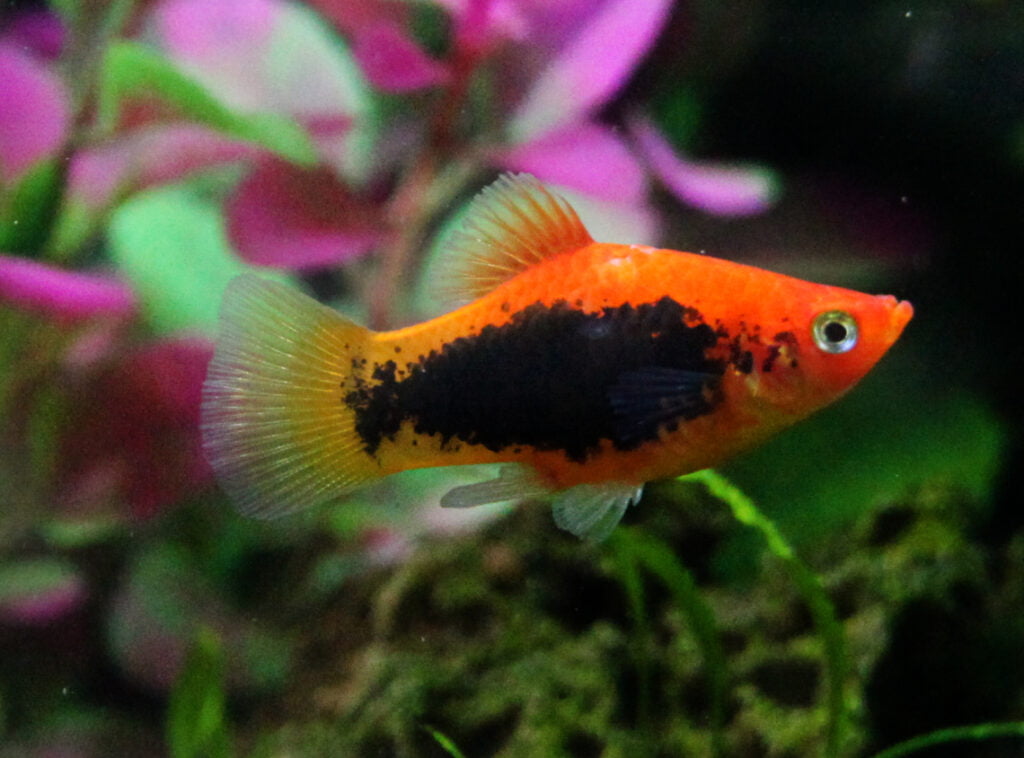
These beauties have a solid-colored body (which can be red, blue, or others) with a black “tuxedo” covering the rear half, giving them an elegant look.
Wagtail Platy
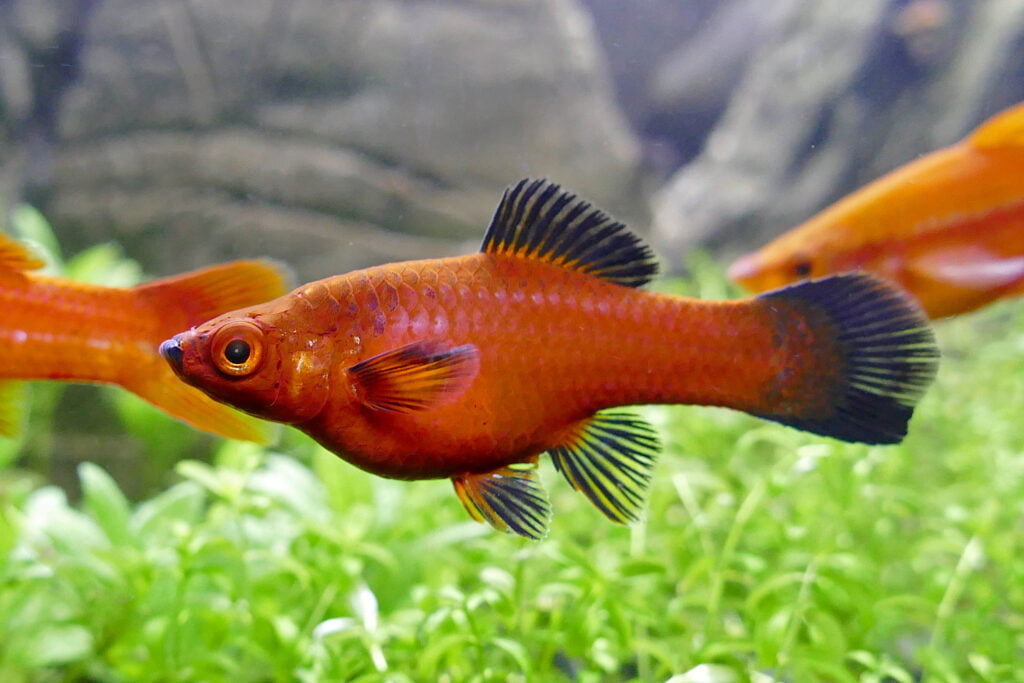
They feature a solid body color with a contrasting black tail, hence the name “Wagtail.”
Salt-and-Pepper Platy
This variant showcases a speckled black-and-white coloration, reminiscent of the common table seasonings.
Mickey Mouse Platy
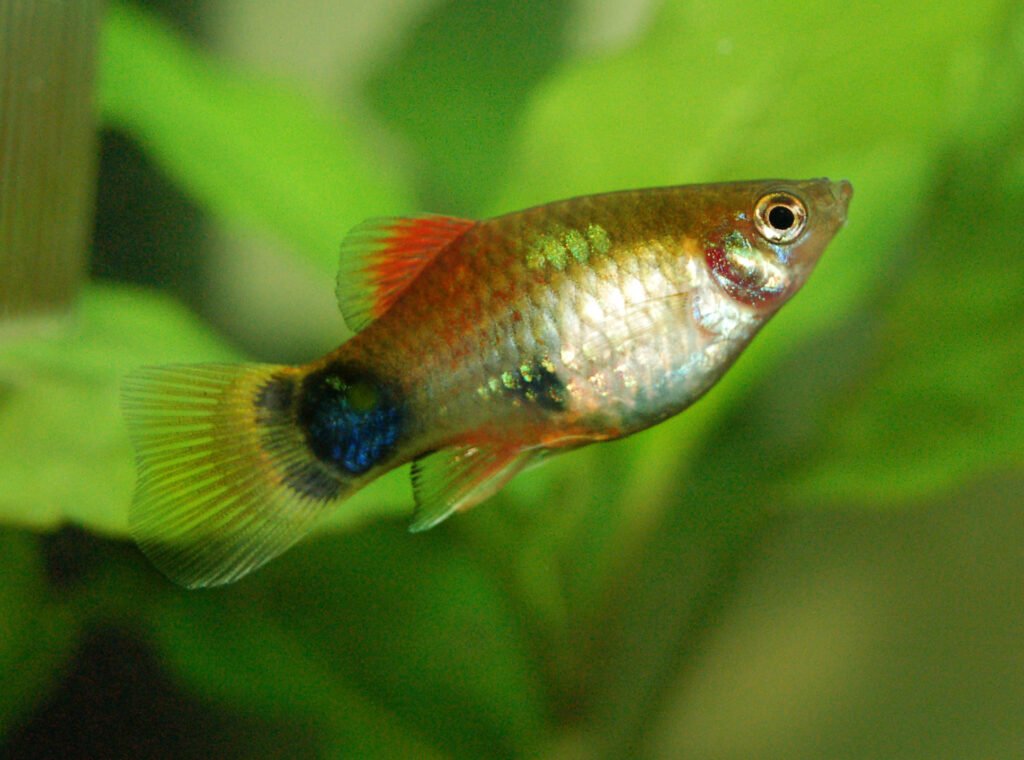
Distinguished by the unique marking at the base of their tail, these fish are a fun addition to any tank.
When buying your Platty fish, the price can reflect the health and quality of the fish. Always make sure to buy from reputable fish stores or breeders to ensure you’re getting a healthy pet.
The Ideal Aquarium: Tank Size and Water Parameters for Platy Fish
Platy fish may be small in size, but they are active swimmers and love to explore. For that reason, the aquarium they call home should provide them with enough space to move freely.
Recommended Tank Size for Your Platies
As a rule of thumb, a 10-gallon tank is the absolute minimum size recommended for keeping platy fish. However, a larger tank (20 gallons or more) would be more beneficial, especially if you plan to keep a group. Keeping in mind that platies are social creatures that prefer to be in groups, an appropriately sized tank will allow them to establish territories, reduce stress, and exhibit natural behaviors.
If you intend to add more platies or other species to your aquarium, be sure to increase the tank size accordingly. The general rule is to provide an additional two gallons of water for each additional platy fish.
Optimal Water Parameters: Temperature, pH, and Hardness
Platy fish are hardy and adaptable, capable of thriving in a range of water conditions. However, like all fish, they have their preferences when it comes to temperature, pH, and hardness.
Temperature: Platies prefer warm waters, so aim for a temperature between 70°F to 80°F (21°C to 27°C). The use of an aquarium heater can help maintain a stable temperature, particularly during colder months.
pH: As for pH, platies prefer slightly alkaline water. A pH range of 7.0 to 8.0 is ideal. Regular water testing can help you monitor and maintain the right pH levels.
Hardness: Platy fish prefer moderately hard to hard water. Aim for general hardness (GH) of 10-28 dGH and carbonate hardness (KH) of 3-12 dKH.
Stable water parameters are crucial for the health of your platy fish. While they are a robust species, drastic or sudden changes can cause stress or illness. Make sure to introduce any changes gradually and keep a regular maintenance routine to keep your aquarium in optimal condition.
Growth and Longevity: The Lifespan and Full Size of Platy Fish
Platy fish make great additions to your home aquarium due to their vibrant colors and playful demeanor. Knowing how much they grow and how long they live can help you plan your aquarium setup and ensure they live healthy, happy lives.
How Big Do Platy Fish Get? Understanding their Full Size
Typically, platy fish are not large creatures. An adult platy fish usually grows to about 1.5 to 2.5 inches in length, though this can vary slightly depending on the specific breed and individual genetics. Male platies tend to be a bit smaller than their female counterparts. Despite their small size, platies are active swimmers and appreciate a spacious tank for exploration.
Expected Lifespan of a Platy Fish in an Aquarium
With proper care and a well-maintained environment, platy fish can live for about 3 to 5 years in captivity. Their lifespan can be influenced by several factors, including diet, water quality, stress levels, and genetic factors.
Ensuring that your platy fish receive a balanced diet, live in a clean tank with appropriate water parameters, and are kept in a stress-free environment with compatible tank mates can help maximize their lifespan. Regular health checks and prompt attention to any signs of illness or disease can also contribute to a longer, healthier life for your platy fish.
Remember, longevity is not just about lifespan, but also about the quality of life. The goal should always be to provide an environment where your platy fish can thrive and exhibit natural behaviors. By understanding their growth and lifespan, you’ll be better equipped to offer your platy fish a comfortable and nurturing home.
Mimicking Nature: Platy Fish’s Behavior, Habitat Preference, and Aquarium Decoration
Understanding the behaviors and habitat preferences of platy fish, as well as the ideal way to decorate their aquarium, can significantly improve their quality of life and provide a more natural, engaging environment.
Behaviors to Expect from Your Platy Fish
Platy fish are peaceful, active swimmers and are often seen exploring their surroundings. They are also social fish and tend to thrive when they are in groups. Being livebearers, you might observe females giving birth to live young if your aquarium hosts both males and females.
Although they are not territorial, platy fish enjoy having enough space to swim around and hide when they feel the need. Occasionally, you may notice that they tend to stay near the top or middle of the water column, although they will explore the entire tank.
Platy Fish in the Wild: Understanding their Natural Environment
In the wild, platy fish are found in the warm, slow-moving waters of Central America and Southern North America. They inhabit small rivers, canals, warm springs, and ditches. These environments are typically abundant with plants and have a variety of hiding places. Mimicking this environment in your home aquarium can help your platy fish feel more at home.
Preferred Habitat and Ideal Aquarium Decorations for Platy Fish
When setting up your platy fish’s aquarium, you should aim to replicate their natural habitat as much as possible. This includes providing an environment with plenty of hiding spots and vegetation.
Substrate: Opt for a soft substrate, like sand or fine gravel, as it closely mimics their natural riverbed habitats.
Plants: Live plants are ideal for a platy fish tank. They not only provide hiding places but also help to improve the water quality by absorbing excess nutrients. Plants like Java Fern, Anubias, and Hornwort are good choices as they are hardy and easy to care for.
Decorations: In addition to plants, include other decorations like rocks and driftwood to offer more hiding spots and to add a natural look to the aquarium. Make sure the decorations don’t have sharp edges that could injure the fish.
While decorating, don’t crowd the tank too much. Ensure there’s enough open swimming space for your platies. An appropriately decorated tank not only benefits the platy fish but also creates an aesthetically pleasing view for you.
Socializing in the Tank: Ideal Tank Mates for Platy Fish
Creating a community aquarium is like crafting a delicate ecosystem where all species coexist in harmony. Knowing the ideal and incompatible tank mates for your platy fish will help you design a peaceful community tank.
Peaceful Companions: Ideal Fish Species for Platy Fish
Platy fish are sociable creatures and generally get along well with a wide range of other peaceful fish. They thrive in community tanks where they can interact with their own kind and other non-aggressive species.
Some ideal tank mates for platy fish include:
- Guppies: Guppies share a similar preference for water parameters with Platies, making them a harmonious match. Their lively nature and small size complement the Platies well.
- Mollies: Mollies and Platies are both livebearers, which means they have similar breeding behaviors. This shared trait makes them compatible tank mates.
- Swordtails: Swordtails are a good match for Platies due to their peaceful nature and similar size. They also share similar dietary needs, which simplifies feeding.
- Neon Tetras: Neon Tetras are small, peaceful fish that add a splash of color to the tank. Their calm nature and preference for middle to lower tank levels make them a good match for Platies.
- Zebra Danios: Zebra Danios are active swimmers that add energy to the tank. Their speed and agility allow them to coexist peacefully with Platies.
- Cherry Barbs: Cherry Barbs are peaceful fish that add a vibrant red color to the tank. Their calm nature and preference for similar water conditions make them compatible with Platies.
- Harlequin Rasboras: Harlequin Rasboras are peaceful, easy-going fish. Their preference for the middle and upper levels of the tank complements the Platies’ swimming habits.
- Corydoras Catfish: Corydoras Catfish are peaceful bottom dwellers. Their preference for different tank levels and their role in cleaning the tank make them a good match for Platies.
- Ghost Shrimp: Ghost Shrimp are small, peaceful invertebrates. Their role in cleaning the tank and their preference for the bottom level make them compatible with Platies.
- Dwarf Gouramis: Dwarf Gouramis are peaceful, colorful fish. Their slow-moving nature and preference for the upper levels of the tank make them a good match for Platies.
- Bristlenose Plecos: Bristlenose Plecos are peaceful bottom dwellers. Their role in algae control and their non-aggressive nature make them compatible with Platies.
- Amano Shrimp: Amano Shrimp are peaceful invertebrates that help control algae. Their small size and non-aggressive nature make them a good match for Platies.
- Endler’s Livebearers: Endler’s Livebearers are small, peaceful fish. Their shared livebearing trait and preference for similar water conditions make them compatible with Platies.
- Black Skirt Tetras: Black Skirt Tetras are peaceful fish that add a unique look to the tank. Their calm nature and preference for the middle tank levels make them a good match for Platies.
- Kuhli Loaches: Kuhli Loaches are peaceful bottom dwellers. Their unique appearance and role in cleaning the tank make them compatible with Platies.
- Nerite Snails: Nerite Snails are peaceful invertebrates that help control algae. Their non-aggressive nature and role in cleaning the tank make them a good match for Platies.
- Rainbowfish: Rainbowfish are active, colorful fish. Their peaceful nature and preference for the upper levels of the tank make them compatible with Platies.
- Cardinal Tetras: Cardinal Tetras are peaceful fish that add a vibrant color to the tank. Their calm nature and preference for the middle tank levels make them a good match for Platies.
- Bamboo Shrimp: Bamboo Shrimp are peaceful invertebrates that filter feed. Their unique feeding habits and non-aggressive nature make them a good match for Platies.
- Rosy Barbs: Rosy Barbs are active fish that add a splash of color to the tank. Their peaceful nature and preference for similar water conditions make them compatible with Platies.
Remember, when adding new fish to your tank, make sure to maintain a balanced male to female ratio for your platies to avoid aggression.
Who to Avoid: Incompatible Species for Platy Fish
As much as knowing who makes a good tank mate, it’s equally essential to know which species to avoid. Any aggressive or overly territorial fish can cause stress and harm to your platy fish. In addition, fish that are significantly larger might see platies as a potential snack.
Avoid adding the following fish to your platy fish tank:
- Cichlids: Most Cichlids are aggressive and territorial, making them a poor choice for a platy tank.
- Bettas: While some bettas can coexist peacefully with platies, others can be aggressive.
- Large predatory fish: Any fish large enough to swallow a platy should be avoided.
- Fin-nipping species: Species such as tiger barbs that are known to nip at fins can cause stress and physical harm to your platy fish.
Selecting suitable tank mates for your platy fish is crucial for a peaceful, thriving community tank. It ensures a stress-free environment that allows your platies and other fish to flourish.
Feeding Your Platy Fish: Best Foods and Diet
Platy fish are omnivores by nature, which means they eat both plant-based and meat-based foods. Providing a varied and balanced diet is key to keeping your platy fish healthy and vibrant.
What Do Platy Fish Eat? Their Natural Diet
In their natural habitat, platy fish eat a mix of small invertebrates, plant matter, and algae. They forage throughout the day, picking off food items as they come across them. This diet provides a good mix of proteins, carbohydrates, and fats, which are essential for their health and well-being.
Top Recommended Foods for Your Platy Fish
To mimic this diet in the home aquarium, a mix of commercial and natural foods can be used:
- Flake and Pellet Foods: High-quality flake or pellet foods make a great base for your platy fish’s diet. They’re formulated to provide a balanced diet and are easy to feed. Look for ones with a mix of plant and animal ingredients.
- Live and Frozen Foods: Supplement the staple diet with live or frozen foods such as brine shrimp, daphnia, or bloodworms. These provide valuable protein and can help stimulate natural foraging behaviors.
- Vegetable Matter: Platies will also appreciate some plant matter in their diet. This can be achieved through spirulina-based flakes, blanched vegetables (like peas, zucchini, or cucumber), or even algae wafers.
Feed your platy fish 2-3 times a day, only giving as much food as they can consume within a few minutes. Overfeeding can lead to obesity and water quality issues, so it’s important to monitor their feeding habits closely.
Tips for Feeding Platy Fish
Remember to vary the diet of your platy fish. A monotonous diet can lead to nutritional deficiencies and reduced immunity. Likewise, ensure that the food is small enough for your platy fish to eat comfortably.
Feeding time is also a good opportunity to observe your fish for any signs of illness or distress. Healthy, happy platy fish should eagerly come to the surface to feed.
Propagating the Species: Breeding Tips for Platy Fish
Breeding platy fish can be a rewarding experience, allowing you to witness the fascinating life cycle of these vibrant fish. Platies are livebearers, which means they give birth to live fry rather than laying eggs. Here are some essential tips to successfully breed your platy fish.
Essential Breeding Tips for Healthy Platy Fish
- Sex Ratio: Keeping a proper ratio of males to females can help reduce stress on the females. A good rule of thumb is to have two or three females for each male in the tank.
- Healthy Diet: Providing a varied, nutrient-rich diet can enhance the health and reproductive readiness of your platy fish.
- Provide a Breeding Space: Providing plenty of hiding spaces in the form of plants and decorations can create a more comfortable environment for pregnant platy fish.
- Watch for Signs of Pregnancy: A pregnant platy will develop a noticeable ‘gravid spot’ near the back of her abdomen. She may also become less active and may refuse food as she gets closer to giving birth.
- Isolation or Breeding Box: While not always necessary, some hobbyists prefer using a separate breeding tank or a breeding box to protect the pregnant female and her fry.
Making Your Aquarium a Welcoming Space for Platy Fry
Once your platy fish gives birth, you’ll want to ensure the survival of as many fry as possible. Here are some tips:
- Provide Cover: Dense vegetation, breeding grass, or specially designed fry hiding spots can provide refuge for the fry from adult fish.
- Consider a Separate Tank: If you have a large number of fry or aggressive adults, a separate fry tank can provide a safer environment for the young fish to grow.
- Feed Nutrient-Rich Foods: Newly hatched fry can be fed high-quality fry food or crushed flake food. As they grow, introduce them to a regular diet gradually.
- Regular Water Changes: Keeping the water quality high is crucial for the survival of the fry. Regular water changes can help eliminate toxins and provide a healthy environment for growth.
Breeding platy fish can be relatively straightforward with the right preparations. With careful observation and care, you’ll soon be able to watch the next generation of platy fish grow and thrive in your aquarium.
FAQs
How many fish can I put in my tank?
The number of fish that you can comfortably house in your tank depends on a few factors, including the size of your tank, the type of fish, and the specific needs of each species. As a general rule, a good starting point is one inch of fish per gallon of water. However, platy fish are active swimmers and do appreciate more space. Always ensure that your tank isn’t overcrowded to maintain a healthy environment for your fish.
How often should I feed my fish?
Platy fish should be fed two to three times a day. Each feeding should only include what they can consume in 2-3 minutes to avoid overfeeding. Overfeeding can lead to obesity and water quality issues.
How do I maintain the water quality in my tank?
To maintain the water quality in your aquarium, regular water changes are necessary. Typically, you should change 10-20% of the water weekly. It’s also important to test your water parameters frequently to ensure they are within the appropriate ranges for your platy fish. This includes the pH level, temperature, and hardness.
How often should I clean my aquarium?
A partial water change (around 10-20% of the tank volume) should be done weekly. As part of this process, you can siphon off any visible waste from the substrate. The aquarium glass, decorations, and any equipment should also be cleaned as necessary to prevent algae buildup. The filter should be cleaned monthly, but the schedule can depend on the type and model.
How to identify if my fish is sick?
Signs of a sick fish can include changes in behavior, eating habits, or physical appearance. Look out for any noticeable spots, discoloration, swelling, or unusual growths on your fish. If your fish is spending a lot of time at the surface gasping for air, hiding more than usual, or seems lethargic, these could be signs of illness.
What are the common diseases in freshwater fish and how can I treat them?
Common diseases in freshwater fish include Ich (white spot disease), fin rot, and fungal infections. Treatments vary depending on the specific disease but often involve adjusting water conditions, medicating the water, and sometimes isolating the sick fish. Always seek advice from a vet or experienced aquarium professional when diagnosing and treating fish diseases.
Can I add live plants to my aquarium? What are the benefits?
Yes, you can certainly add live plants to your aquarium, and there are several benefits to doing so. Live plants improve water quality by absorbing excess nutrients, they provide shelter and hiding spots for your fish, and they also enhance the aesthetics of your aquarium.
What is the behavior of a platy fish before death?
Platy fish nearing the end of their life or in poor health might exhibit lethargy, lack of appetite, irregular swimming patterns, or spend a lot of time at the bottom of the tank. However, these signs could also indicate illness, so it’s important to check for other symptoms and seek advice if you’re concerned about your
